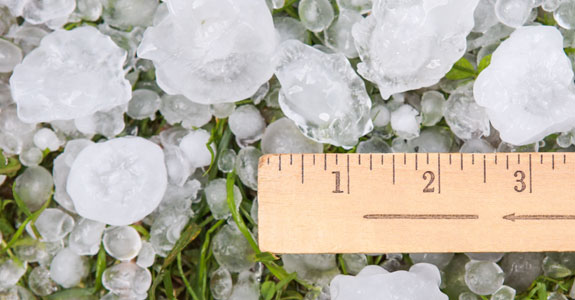Help protect your horticultural business from hail damage
When you own a business in the horticultural industry, seeing a hailstorm in the forecast will certainly get your attention. According to the National Oceanic and Atmospheric Administration's (NOAA) annual severe weather 2023 report, there were 6,962 reports of severe hail (1-inch or greater in size) in the United States. That’s an extra 1,000 incidents of quarter-size hail than we saw in 2022.
NASA's global climate change models predict hailstorms may become more intense due to the warming climate. NASA also states that hailstorms are more likely to form than tornadoes—and often cause more costly damage than hurricanes. So, if you own a horticultural business anywhere in the U.S., you may have to deal with hail damage at some point.
Be prepared before a hailstorm hits
Are you prepared for a severe hailstorm? Here are several ways you can help mitigate your losses as hailstorms become a more frequent, unwelcomed guest.
Keep an ongoing, detailed inventory of your plants and crops so you can review it if you experience damage during a storm.
Ensure your structures, bracing, and coverings are secure.
Inspect your property for dry or weak tree limbs that could fall on your structures.
Clear debris from downspouts and drainage systems to help water flow away from your structures.
Have materials on hand to quickly repair damage once it’s safe to do so.
When a severe storm is forecasted, move your outdoor items—including equipment and crops, if possible—under sturdy structures to help avoid damage.
Keep your insurer’s contact information readily available and be prepared to report damage to your crops, equipment, or facility.
Hail damage to anticipate
Hail isn’t just a threat to your outdoor crops or those within your greenhouse structures. It can do significant damage to your property as a whole. Hail can crack or penetrate even the most impact-modified cladding (coverings)—potentially damaging the interior shade system, controls, and equipment.
In addition to your crops, hail can damage:
Delivery vehicles
Irrigation and fertilization equipment
Roofs, siding, and windows
HVAC equipment
Hand-held machinery, such as chainsaws
Smart technology controls
Lighting systems
Robotic equipment
Steps to take after a hailstorm
Once the hailstorm and related weather system has passed, it’s time to assess the damage.
For their safety, block employees and customers from affected areas. Keeping the areas clear will also help you accurately assess the damage.
Take photos and videos of the damage from various angles, as well as the hailstones—when possible. In-depth documentation can help speed up the claims process.
Contact your insurer to start the claims process. Your insurance provider can help you quickly find a local contractor so they can ensure structures are secure and begin mitigation efforts to protect your plants and crops.
Insurance for hailstorm damage
Hailstorms can’t be prevented, but commercial property insurance is one of the best ways to help protect your company from losses related to hail damage. Your commercial property insurance can be customized based on your buildings, equipment, inventory, income, and other exposures.
Depending on your policy, coverage can apply to the equipment contained within your buildings or greenhouses, including:
Boilers
Generators
Coolers
Benching systems
Irrigation equipment
Heat retention curtain systems
Environmental control computers
You may also receive reimbursement for lost business income as a result of damages to your property. Work with your insurance provider to make sure you have the proper commercial business liability coverage.
Select a provider who knows your industry
Having an insurance provider who’s focused on the particular risk exposures and unique characteristics of businesses within your industry can give you peace of mind.
With more than 135 years serving the horticultural industry, we understand the impact a hailstorm can have on your business. We can work quickly through our cultivated networks of local contractors in your area to help you get your business up and running again.
You also want to be sure your company and employees can identify and help mitigate hazards. Our safety services team can tailor a loss control program that can help your business prepare for severe weather events.
If you have any questions about insuring your business or would like to review your current policy, contact us today or complete this simple form to request a quote.
Related links:
If you suffer hail damage, you need to file a claim. Follow these five tips when reporting a claim to help get your claim started, processed, and settled more quickly.
Learn about two other critical types of business insurance coverage that play major roles in helping protect your horticultural company.
Preparing for severe weather should be part of your safety plan. Learn why taking a proactive safety approach can help improve your business operations and your bottom line.
The information in this article is for informational or entertainment purposes only. View our disclaimer by going to terms and conditions and clicking on Learning Center disclaimer in the table of contents.
